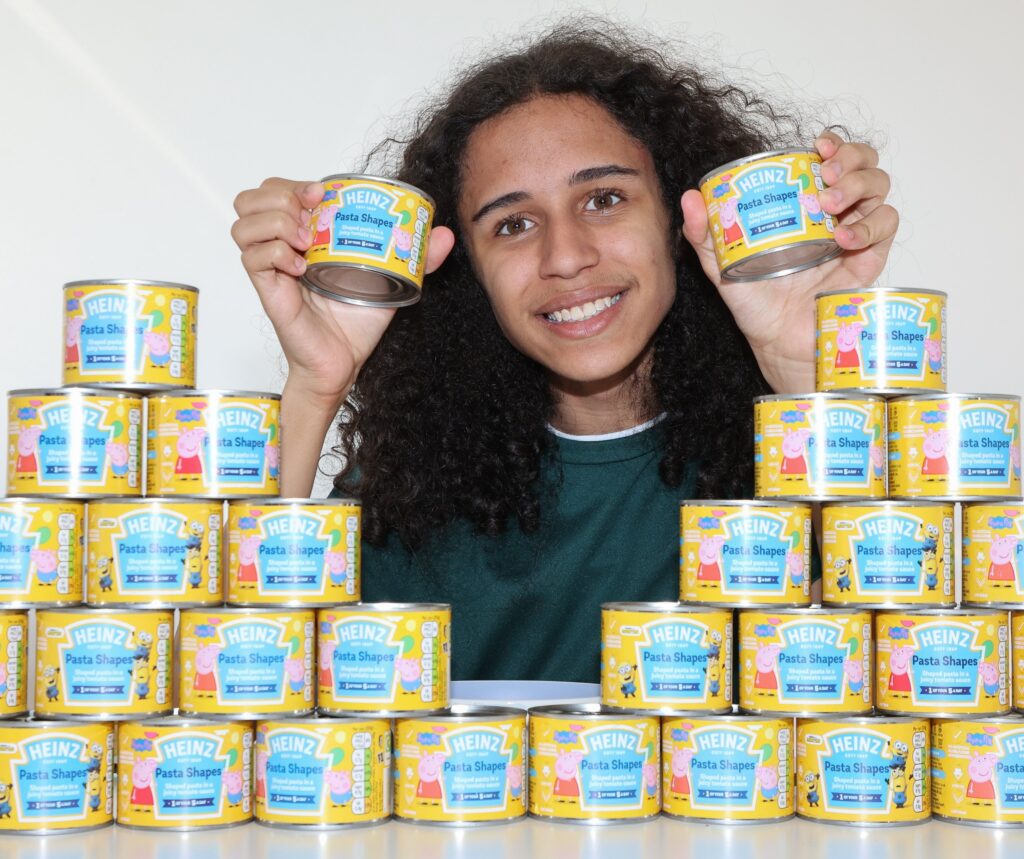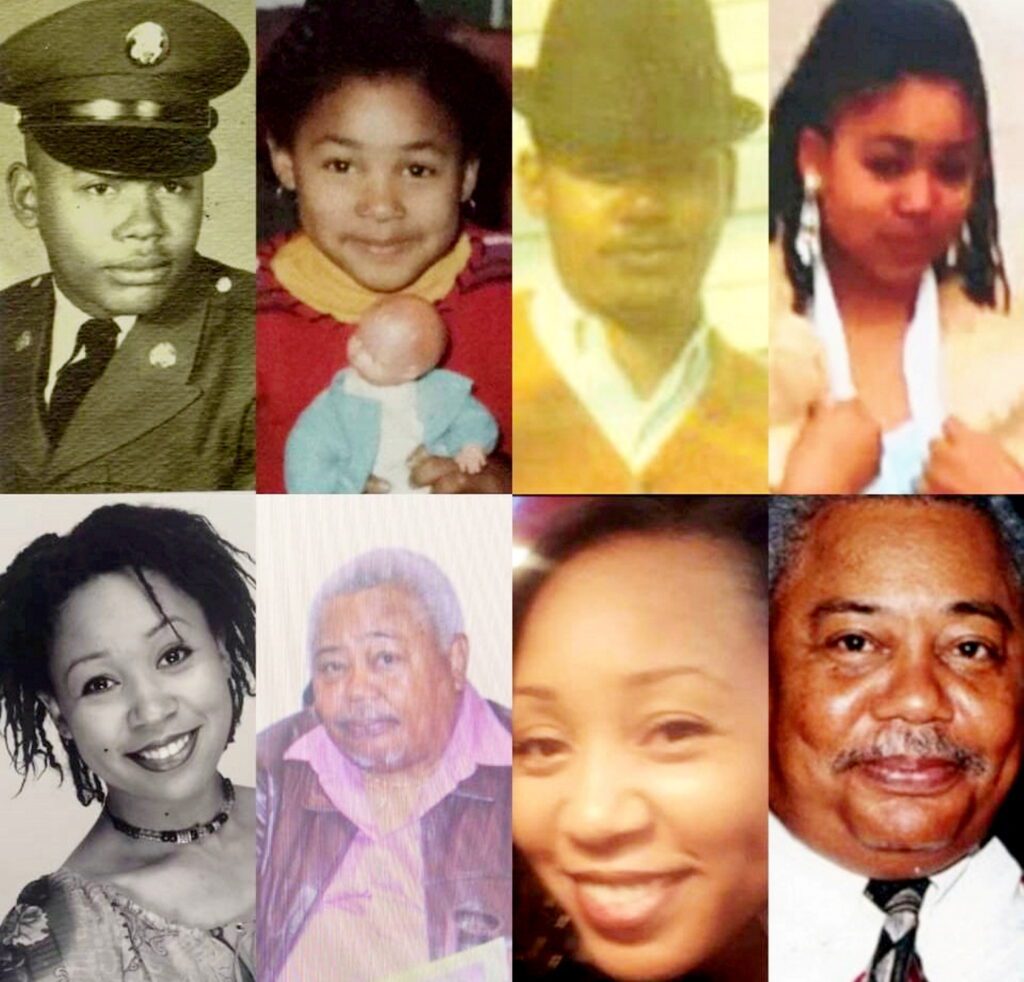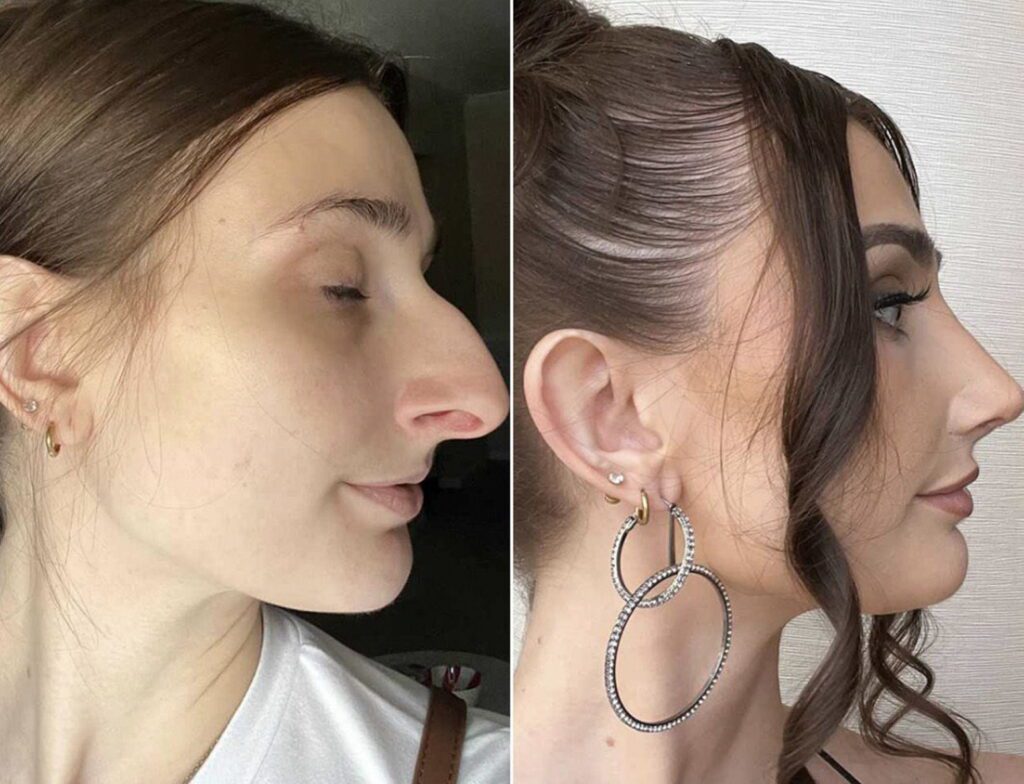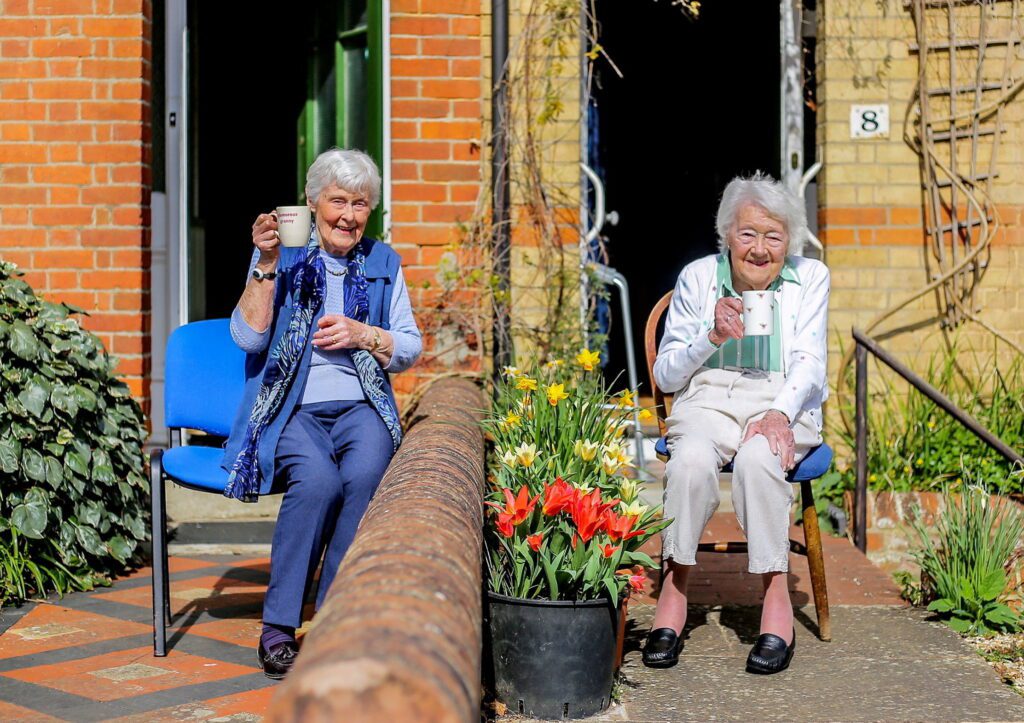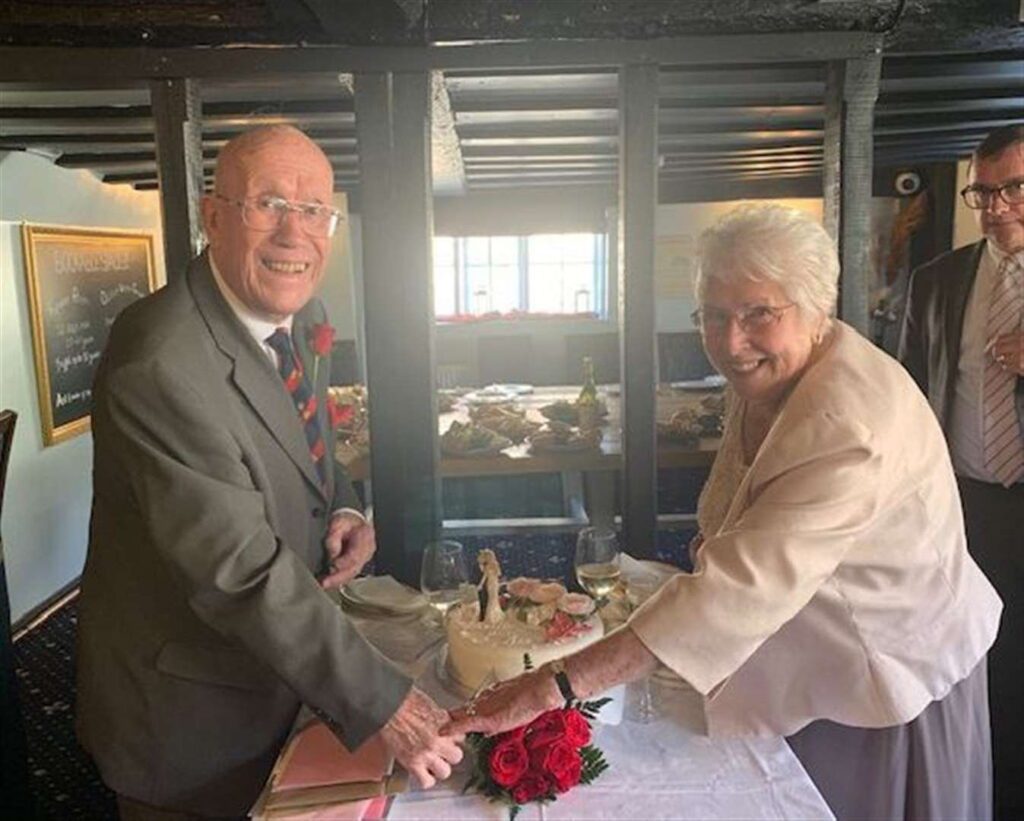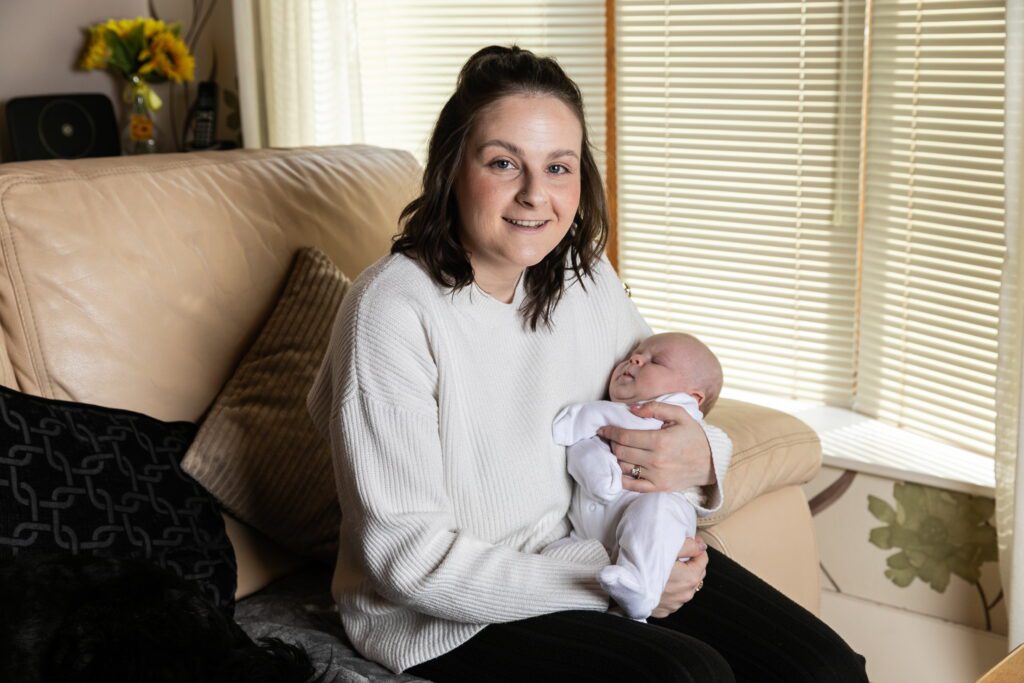Teen only ate Heinz Peppa Pig pasta shapes for 12 years
A schoolboy who only ate Heinz Peppa Pig pasta shapes for 12 years has finally had a proper meal – thanks to hypnosis.
Curtis Maxwell, 14, would gag if he was forced to eat anything other than the tomato-sauce pasta.
The teen would trough up to five cans of the novelty-shaped pasta every day – costing mum Kylie more than £100-a-month in food bills.
In desperation Kylie contacted David Kilmurry, a specialist in obsessive eating conditions, who diagnosed Curtis with ARFID.
ARFID — avoidant-restrictive food intake disorder — can make sufferers oversensitive to the taste, texture, smell, look and even temperature of certain foods.
After a series of two-hour sessions, Curtis now has more than ten foods which he is willing to try.

Kylie, from Rugby, Warks., said: “His obsession with Peppa Pig pasta started as soon as we started weaning him.
“He just wouldn’t eat anything else and fruit and vegetables were a definite no go.
“He would also eat some crisps and digestive biscuits but for his main meal it was always pasta shapes.
“He was a happy healthy boy but he would scream or moan if I put anything else in front of him.
“He did eat the Heinz Minions shapes or Thomas the Tank Engine but his favourite was Peppa Pig and it just went on for years.
“The health visitor said it was food regression but the problem is he never came out of it.
“I used to buy more than 30 tins a week in bulk from Asda. It was ridiculous.
“He’s suspected of having sensory processing disorder and the ARFID coincides with that.
He has issues with texture and taste, it’s obviously very similar to children who suffer with ARFID.”
He is now able to tuck into a variety of foods, including his new favourite which is a six-inch turkey sub sandwich.
Kylie, a cleaner, added: “Things came to a head when he went to a friend’s house after school and I had to send him with tins for tea and the boy’s parents looked at me like I was mad.
“I knew we had to do something to break this cycle.
“It’s difficult for him now that he’s a teenager it’s hard for him to be able to go out and socialise with friends.
“They’ll pick up chips and pizza and he just can’t eat that.
“He was in and out of hospital having tests done because he couldn’t stop vomiting.
“He‘d had ultrasounds, blood tests, they’d done everything but they couldn’t see anything wrong.
“They said it could be his restrictive diet causing him to be sick.”

After four hypnotherapy sessions Curtis has tried passion fruit, mango, balti mix, sugar snap peas, blood oranges, lemons and peanuts.
Single-mum Kylie added: “We’ve had four sessions and we’ve been making some real progress, I don’t think I’ve seen him try as much food.
“Peanuts are a new favourite which was unfathomable before. He actually likes them.
“I think the therapy is opening up his pallet, he’s realising there’s favourite he likes.”
Hypnotherapist David Kilmurry says he is “thrilled” with Curtis’ progress since he started treating him in February this year.
He said: “Curtis has superseded my expectations and has taken to the therapy extremely well.
“Having had the food therapy myself I do understand it, I do connect quite well with fellow ARFID sufferers.
“Curtis has just jumped in feet first, he’s been for pizza with me, he’s been for Subways with me and we’ve only done three sessions. So we’re doing very, very well.
“I have absolute faith that he is fully recovered from the food phobia.”
Parents of bullied girl, 10, who took own life to sue “negligent” school
The parents of a bullied ten-year-old girl who took her own life are planning to sue her school for alleged “negligence.”
Autumn Brooke Bushman, 10, of Roanoke, Virginia, died on March 21, devastating her parents, Mark and Summer Bushman, and two older siblings.
And following a memorial over the weekend, the parents have accused Mountain View Elementary School of failing to act upon their daughter’s bullying complaints.
The Bushman’s revealed they have since discovered Autumn kept a newspaper clipping about Aubreigh Wyatt – a 13-year-old girl from Mississippi who took her own life in 2023 – in her desk at home.
They say Autumn was initially bullied over her teeth, but this escalated this school year to physical threats.
And they claim nothing was done by the school when they complained – and they were never informed about visits Autumn made to the school counselor.
“We can’t stop voicing our concerns,” Mark, 36, a senior logistics analyst, said of parents raising bullied children.
“We have to come together and figure out a plan. We can’t keep fighting the same battle. The school must take accountability.”
At around 9:30 p.m. on March 21, Autumn told her mother goodnight before going to her room.
“I went to my bedroom and went to sleep,” Summer, 36, a payables specialist, recalled.
The next morning, she discovered the unimaginable.

“Her bedroom light was on, which was odd because she never slept with it on,” she explained. “The door was locked, and I couldn’t get in.
“My 17-year-old son came out of his bedroom, and I told him she wasn’t responding. I broke down the door, and that’s when we saw her.”
Summer, who hasn’t publicly discussed the cause of Autumn’s death, would only say that her daughter kept a newspaper clipping about Aubreigh Wyatt in her desk — something discovered after the fact.
Aubreigh Wyatt — the 13-year-old girl from Mississippi who made headlines in 2023 after committing suicide — was, like Autumn, a victim of bullying.
“I don’t want many details released,” Summer said. “I don’t want any girls to repeat this.”
Paramedics arrived, but it was too late.
“They came right back down and said she was deceased. There was nothing they could do.
“I was in complete shock and denial. All I could do was scream. It was the most horrific thing I have ever seen.”
Mark recalls changes in Autumn’s demeanor before her death.
“She wore bright, vibrant colors growing up, but then shifted to earthy tones, blue and black. In hindsight, maybe she wanted to fly under the radar.”
Her energy levels also declined.

“She wasn’t as excited about things she used to love. In the last two or three days, she took naps, which was really unusual for her.”
Still, Autumn maintained connections with friends.
“She still had a close friend next door, a girl around her age,” Mark said. “They were playing together and laughing a lot and doing the normal things.
“She did have moments where she was happy and bubbly.”
But those moments contrasted sharply with what she endured at school. Autumn, a fourth grader at Mountain View Elementary School, was frequently teased.
She had enamel hypoplasia – a developmental defect causing thin, weak, or missing enamel – and Mark said she was “made fun of for her teeth.”
“She came home crying to me,” he said.
During this school year, however, the bullying cast a darker shadow over her life, escalating beyond cruel words to threats of physical confrontation.
“One girl told her on the bus, ‘Meet me in the bathroom when we get to school.’
“When we addressed it, all we got was, ‘We’ve handled it.’ That’s why it continued. There were no real consequences.”
He added: “It got very cruel. It wasn’t just about her appearance but anything that was low-hanging fruit.”
Autumn frequently complained about bullying — even visiting the school counselor — but her parents say they never received a call.
“Nobody ever called us,” Mark said. “When we suggested contacting the school, Autumn didn’t like that idea.
“It came from previous times when she went to the counselor. It only made things worse. The aggressors found out and faced no repercussions.”
Now, the Bushmans are determined to fight for change.

“We do plan on taking legal action against the school,” Summer said. “Those are conversations we’re having.”
Along with their 17-year-old son, Summer has a 12-year-old daughter who she describes as “Autumn’s best friend.”
The family is left mourning their beloved daughter and sister but remains committed to making a difference.
“We want something good to come of this,” Mark said. “I know our daughter would want that. She passed the torch to us, and we want to run with it.”
Summer remembers her daughter’s vibrant personality.
“Autumn was a very, very special little girl. She loved so hard and wanted to be loved by so many. She just lit up a room. She smiled with her eyes.”
Mark added: “In just 10 years, it feels like she fit an entire lifetime of joy, laughter, and love.”
Mountain View Elementary School did not immediately respond to request for comment.
www.gofundme.com/f/vgeysg-help-a-family-heal-after-tragic-loss
British gran finds US father after 37 years thanks to 23andMe DNA test
A gran found her birth dad after a 37-year search thanks to a 23andMe DNA test.
Anna Sharp, now 52, learned aged 14 she had a different biological dad to her seven older siblings – but she had no idea who her birth dad was.
All she had was an old photo she found in her mum’s belongings and a love note signed ‘Carlos’.
Her children gave her a 23andMe kit for her birthday in February 2024 – a saliva-based DNA service which provides family history and can connect people with relatives.
In July she got a message from fellow user Jasmin Andrews from L.A – a DNA match.
It turned out the pair were second cousins which allowed Anna to track down her birth dad, Charles W Sharp Junior, now 79, an ex-soldier who lives in Dallas, Texas, in October last year.
Now Anna and Charles speak every day and she’s jetting out to see him in April.

Anna, a student nurse from Milton Keynes, said: “Finding him has been amazing!
“It’s easily the best experience in my life.
“I’m so excited to be going to meet him.
“We’re going to revel and live in the moment to make up lost time.
“We’re very similar – we both love to talk, and we have the same sense of humour.
“We even hold our hands up by our faces in the same way.
“I felt so lost not knowing who my biological dad was, like I didn’t really know who I was.
“I felt a real void when I looked in the mirror and didn’t know about the person looking back.
“It’s lovely to feel whole now.”
Anna said she had different skin tone and hair texture from the siblings she grew up with in Wolverhampton, and aunts and uncles made odd comments, so she always had an inkling she had a different dad.
Her mum, Shirley Johnson, a dancer who died in 2021 aged 76, told her she had a different dad but wouldn’t give any more information.
Anna said: “It was a real shock but a lot of things started to make sense.”
Anna asked for information when she was 18, and again aged 25, but relatives just said she needed to speak to her mum.
She said: “My mum just wouldn’t tell me anything.
“I guess she was protecting the life she had built up.”

Since speaking to Charles she has discovered the pair met in Germany, in 1971, where Shirley was working for a year, and Charles, a US soldier, was recovering from a bullet to the head he sustained while fighting in Vietnam.
Charles later visited Shirley in the UK – and while both were married, they had a short affair before he was posted back to the US before Anna was born in February 1973.
Shirley never told him about their child, and separated from her husband before Anna was one.
Anna chanced upon a picture with a love letter from ‘Carlos’ on the back in one of her mum’s albums when she, Anna, was 36.
She learned he was a soldier and the note said how he always loved her mum, but despite online searches, Anna was no closer to tracking him down.
Anna found she had two DNA matches in April 2024 – and reached out to two cousins but got no reply.
Later she connected with Jasmin who revealed she had an “uncle Charles” – her grandad’s sisters son – and they compared photos, to discover he was Anna’s dad.
“I started crying’, Anna said, “I’d found my dad.”
Anna reached out to Charles via Facebook Messenger, and they exchanged photos before a phone call on October 3 last year.
She said: “I was shaking like a leaf.
“When he answered we both just kept saying ‘hello’.”
Gran-of-four Anna discovered her dad has been awarded two purple hearts for being hit in action.
He’s worked as a policeman, an accountant, and an engineer.

Anna changed her surname to match her dad’s, in January – from Johnson, her mum’s ex-husband’s name.
She’s the third-born of Charles’s six children, but he knew nothing about her until she contacted him.
Anna and her son Thierry will meet her half sisters Martina and Kei and half-brother Richard: they fly out on April 22.
She said: “It’s amazing and we have so much still to do together.
“We’re still at the beginning, which is very exciting, but I do wish we had both been spared the pain of separation and not knowing.
“We have to make up for lost time and lost memories. My mum had her reasons and I love her.
“But I think it’s really important to know the two people who have given you life.
“I have a new sense of belonging now and it’s a huge relief.”
Charles said: “It was a shock but a lovely one, and a lovely early 79th birthday present.
“I wish I had known earlier because I would have wanted to be involved all her life.
“I’m so glad Anna didn’t give up on her search.
“I can’t wait to give her a big hug.”
“My $11k nose job gave me clarity to ask for a divorce – now I’m glowing”
A woman underwent a post break-up “glow up” and says her $11k nose job helped her get “clarity” to ask for a divorce.
Devyn Aiken, 30, “grew apart” from her husband of seven years and the pair separated two years ago.
But it was after Devyn underwent a nose job that she says it finally gave her the “clarity” to ask for a divorce – after putting herself first.
Now she feels “reborn” and has realised she is “strong” and doesn’t want to “settle”.

It comes after singer Lily Allen revealed during an episode of her ‘Miss Me?’ podcast that she had a boob job after splitting from her actor husband, David Harbour.
Devyn, who works at a drug addiction company, from Philadelphia, Pennsylvania, US, said: “I was re-born in a way [after the nose job].
“I thought ‘I’m choosing myself’.
“I feel so happy.
“You can start over whenever.
“I know what I want now.
“I don’t have to settle.
“Life doesn’t end when you go through divorce.”
Devyn got married at aged 23 and says she felt “stuck” in the marriage but felt she needed to stay in it to “prove” something to society.
She said: “I stayed in a stagnant, unhappy marriage.
“It was wrong just to stay together because of all the time we’d had.
“The last few years we grew apart.
“Everything didn’t align anymore.”


The couple separated two years ago which helped give Devyn the push to do something she had always wanted to do – get a nose job.
Her nose had always been her “biggest insecurity” but she had never found the right doctor to make her “pull the trigger” on surgery.
Devyn said: “Middle school was rough with bullying.
“I was called a witch, toucan, Pinocchio.
“It’s something I couldn’t control.”
After finding Dr Ginsburg on social media she booked in her consultation and underwent the five-and-a-half hour surgery in November 2024 – using her own savings to pay for it.
She spent three to four weeks recovering – and the swelling can take a year to go down fully.
Devyn said: “Having so much down time with my nose job it gave me the time and clarity to think about divorce.
“It made me think ‘I can do this – I’m strong enough’.”
She filed for divorce in December 2024.
She said: “I feel a sense of happiness.
“This is my me era.
“I’m not settling.
“I’m OK to be alone. I’m a strong independent woman.”

Devyn has been sharing her “glow up” on @doseofdevy and has been flooded with comments – and helped inspire others to leave their relationships.
She said: “Someone commented ‘I’m not married but I need a divorce so I can have this glow up’.
“It’s an internal glow – I radiate that externally.
“People have said I look like Bella Hadid, Celine Dion – all sorts.”
Devyn now feels “optimistic” for the future.
She said: “I have my own apartment – I can decorate it like I want it.
“I can have pink bedsheets.
“I’m going out more with my friends.
“I’m going to enjoy life – do some travelling, dating – I’m excited for that.
“I’m optimistic.
“It has been life changing.
“I’m embracing and welcoming the change.”
Girl’s Rare Syndrome Leaves Her Feeling “Trapped in Her Body”
A little girl who would fall over up to 40 times a day was diagnosed with a rare syndrome – which leaves her feeling “trapped in her body”.
Matilda Monerawela, 10, was born with a neurodevelopmental disorder caused by mutations in the CTNNB1 gene – which provides the body with instructions for making a protein for cell development.
Her parents Amy, 40, and Cian, 34, noticed Matilda was behind on her development as a baby – but Amy initially “blamed herself” as a first time mum.
After going back and forth to the doctors since Matilda was around aged one a full exome test revealed her gene mutation when Matilda was aged three.

Now Matilda requires 24-hour care, struggles to communicate, uses a wheelchair because it is so painful for her to walk and has “dangerously violent” outbursts.
The family are fundraising to help a lifechanging drug get to clinical trials. The gene therapy – if it works – could help Matilda walk and talk.
Matilda is just one of 430 known to have CTNNB1 syndrome.
Amy, a speech and language therapist, from Torbay, Devon, said: “A lot of what she does is really held back by her body.
“She is trapped in her body.
“She wants to be like everybody else.
“We want her to be able to go out in the world and do what she wants to do without being reliant on other people.
“And if it works, even if she can regain 50% of her functioning. That could mean that she could have a normal life.”
Amy had a normal pregnancy until the midway point when they noticed Matilda’s head was very small.

Matilda was born on January 6, 2015 after Amy was induced when her Matilda’s heart rate slowed to “dangerous rates”.
Amy said: “We were always certain in the beginning when her development wasn’t quite right, that she had cerebral palsy and that it was birth damage, because when she was born, she was quite lethargic and she didn’t cry.
“In hindsight, things were wrong from the day she was born.”
As a first time mum, Amy said she had “no frame of reference” and “blamed herself” when Matilda was not hitting normal milestones like lifting her head and sitting up.
She said: “She didn’t smile at me, she didn’t look at me. It was really difficult to form a bond with her because it felt like it one way.
“As parents, you feel like you’re doing something wrong, so you blame yourself.
“You go to the parent groups and the baby groups and all the babies are doing these lovely things like rolling and crawling and sitting up and your baby’s not doing any of it. It was very, very isolating, very lonely and very scary.”
Amy said they were not taken seriously by doctors until Matilda was two years old when she started having lots of tests.
Her condition remained a “mystery” after an MRI of the brain showed no sign of injury and her parents assumed Matilda had cerebral palsy.
Amy said: “This was when the fight began. The fight is ongoing, a daily struggle.”

Amy decided to quit her job in human relations and took a course to become a speech and language therapist so she could understand more about how to help her daughter and others.
She said: “You have to become a medical expert.
“You have to learn everything about paediatrics. You become one of those people that doctors dread, but you have to.”
Matilda only took her first steps aged three and a half but due to spasticity in her legs she used to fall 30 to 40 times a day and would often injure herself.
Amy and Cian, a maintenance manager, would cover the lounge with massive fluffy rugs to break her fall.
After years of searching for answers for Matilda’s health a neurologist at Bristol Children’s Hospital suggested a full exome test which was their “final shot” in 2018.
Amy said: “We put her through so much testing and we didn’t want to do it to her anymore. So we said, right, this is the last thing.”
The test revealed her diagnosis which was “lifechanging” but the parents have continued to struggle – as well as Edith, eight, who is a young carer for her sister.
Matilda’s diagnosis helped Amy connect with other parents and get in touch with Spela Mirosevic, a Slovenian researcher who has brought together scientists across Europe and America to create a new drug.
The drug is a type of gene therapy which has already been developed, and it has been recognised by the European Medicines Agency (EMA) and the US Food and Drug Administration (FDA) as a promising therapy.
If they can refine the technology they drug can potentially target any genetic condition.
But the CTNNB1 foundation – who have developed the drug – need £1m to move the treatment into clinical trials.
Amy has set up a GoFundMe to raise £45,000 to fund the “final step” in this gene replacement therapy and hopes that, if the new drug is successful, Matilda may not have to move into a residential school and can stay living with her family.

If the drug works, even at Matilda’s age, her parents say there is a good chance she could walk and talk and that “she wouldn’t have these terrible outbursts or anger” and “could have some independence”.
She said it would also allow for little sister Edith “to have a little bit of her life back.”
By the time the drug gets the funding it needs to help the children, it may be too late for Matilda to make a full recovery but her parents hope the drug will help the next child.
Amy said: “It will help future children. And if a child is born and they’re not really sure why they’re not developing properly, if you give this to a baby and it works to fix the faulty gene, you would be looking at a full recovery.
“It is not just for Matilda, it is for so many other children. They deserve a life that is free of pain and full of opportunity.”
You can donate here – https://www.gofundme.com/f/the-future-of-gene-therapy-starts-here-fund-the-final-step
Neighbours celebrate joint 101st birthday – and share secrets to long life
Two next door neighbours are both celebrating – their 101st birthdays.
Josie Church and Anne Wallace-Hadrill have lived side-by-side in Oxford since the 1980s.
The great-grans share something else in common – the same birthday after being born on the same day in 1924.
Josie said: “I think life has gone quite quickly.
“Anne was very busy when she was younger, so was I, and was very productive and creative.
“She did a lot of painting and tapestry, and she was always busy, and I was always busy doing something else, somewhere else, because that’s the sort of life we live.
“I don’t think we’ve thought much about the time passing. It’s just passed.”

Both women threw themselves into volunteering and creative activities after their husbands died.
Josie’s husband, Peter, passed away shortly in the 1990s and the women formed a friendship.
Anne, who grew up in Hampshire, first moved to the house following the death of her husband, John Michael Wallace-Hadrill, an historian.
She read English at St. Hilda’s College, Oxford University, and served in the Women’s Royal Naval Service as a radio mechanic during the Second World War.
St. Hilda’s was an all-female college at the time, but Anne says: “We weren’t forbidden from seeing men.
“We were expected to live decent lives.”
She says she enjoyed university, but it was both a lot of fun and a lot of work.
She met her husband at a family gathering.
After graduating, Anne worked as a lexicographer for the Oxford English Dictionary.
She said: “I was always interested in words. It was my trade.”
She was very proud to receive a medal for her service from the Royal Navy last year, described as “long overdue” by the representative who gave it to her.
Originally from Manchester, Josie did her training at Preston Royal Infirmary and remembers the introduction of the NHS.
She said training was “three years of hard work”.
“In those days,” Josie said, “You had to live in and you couldn’t get married, and it was very strict. People wouldn’t put up with that sort of life now.”
Her time nursing during the Second World War included a “chilling” experience of caring for SS German soldiers.
Josie said: “They weren’t very nice. They didn’t wish to be taken care of by us. They were very difficult patients. “
She moved with her husband to Oxford so he could continue his degree at University College, interrupted by the war, and they “lived the life of an undergraduate”.
Half of the undergraduates had been to war while the other half were young students just matriculating.
Josie said: “Oxford was very strange because each college had a large intake of older people who’d gone through the war and were taking up their university places.
“So you’d get the old men and then the young 18-year-olds coming in from school.
“Oxford wasn’t like it is now. There were quite a lot of married undergraduates, which you don’t get, I don’t think, now.”

After marrying, she worked for a while and looked after her family.
Her husband was a housemaster at a boys’ boarding school, and she was the house nurse, meaning she had an “interesting” few years looking after 120 boys.
She has three “wonderful” children – Chris, Pamela and Andrew.
Anne’s son James lives in Poole and Andrew in Cambridge.
They don’t remember the moment they discovered they had the same birthday but enjoyed the celebrations arranged for them last year.
“We live in the most amazing road. It’s like one big, extended family,” Josie said.
“Everybody knows everybody else. If you have a problem, you just give a shout and somebody will come.
“It was wonderful, we had a lovely day last year. It was quite unexpected because I didn’t know anything about it.
“It’s just an amazing street. I think we are lucky.”
As for tips to lead a long life, Josie says: “Just live.
“There’s not much you can do. You just go on from one thing to the next.
“You do what seems to be needing doing, and then you do that, and then something else takes its place. You just go on from one thing to another.
“We don’t engineer our lives. I think they’ve just engineered us.”
They were both born on April 1, 1924.
“I’m a busy mum but I still go on multiple holidays – and I leave my kids at home”
Meet the busy mum who still manages multiple holidays each year – by dropping her kids off at their grandparents’ then jetting off for 24 hours.
Monica Stott, 37, from Wrexham, northeast Wales, has become a fan of mini breaks – also known as extreme day trips (EDTs).
These short and sweet holidays involve her leaving her house at 5am and returning home by midnight to sleep in her own bed again.
The mum-of-three, with kids aging from five to ten, tends to plan her trips mid-week to get cheaper flights, stating that all her journeys have cost under £40 per country.
For example, she flew to Dublin for just £22, and a ticket to Budapest only cost her around £15.
Monica also says that midweek is ideal for arranging childcare – since her kids are already going to be at school all day.
They then stay with their grandparents for the day, and she is back home with them by the time they wake up the next morning.

Overall, Monica says that it is mostly men who don’t understand the trips – while she claims that mums usually get the appeal.
She added: “It is really cheap, much cheaper than having a day out in the UK.
“I think a lot of people don’t get it. I personally find that it is always the men who think it is a waste of time. They say that the airport is too stressful.
“It feels like this is for mums who are really busy and want to have a holiday but will never have time to get away without the kids.
“Busy mums with jobs and children are really keen on the idea.”

Monica first had the idea when she began flying to Dublin for the day to meet clients and realised that it felt like a holiday.
She said: “I had a client in Dublin so I used to pop over for meetings and while I was there I would make a day out of it. Then I realised that it did feel a bit like a holiday with the exception of the meeting in the middle.
“As I have gotten older, I have more responsibilities. I have three children, a dog, and a garden where all my plants will die if I go away for a week.
“I just love the adventure of having these quick trips. I am always surprised that it feels like I have had a holiday.
“It is a lot easier to arrange with other people as well. If you say is anyone free next Thursday, then they can come but nobody is ever free for a weekend away.”
Monica’s favourite holiday so far was her day trip to Reykjavik, where she explored the city and then spent her afternoon relaxing in a spa.
She has also been to places like Bergamo and Alicante.
Since beginning her trips, the mum says that she has begun seeing many other people on the plane who are doing the same as her.
In the future, she is hoping to do even more EDTs with plans to take all of her children on individual adventures for their birthdays.
And she says that despite the long days being exhausting, it is always worth it in the end.
Monica said: “It is a long day but it is really fun and there is something about the adrenaline of knowing that you are only there for a day.
“It is so strange coming home and going to bed because you feel like you have been away for so long, but you got out of the bed that morning.”
Rupert Grint lookalike is stopped daily but says “it’s nice to have attention”
A man who is mistaken for Rupert Grint and Ed Sheeran says he is stopped for photos daily but “it’s nice to have the attention”.
Lewis Parker, 33, was first told he looked like Rupert Grint while watching Harry Potter with his mum, Lorraine, 54.
The fan said he was bullied for being “ginger” and looking like “Ron Weasley” – and even dyed his hair to avoid being called names.
But now he has turned his negative experience into a positive and is paid to be a lookalike – doing meet-and-greets, birthday parties, and events.

Lewis, a marble mason, from Spalding, Lincolnshire, said: “In the first movie, my parents noticed the resemblance straight away, and it progressed, and my mum wanted to go to a lookalike company.
“I have worked closely with other Harry Potter look-alikes for 10 years, and I’ve appeared on the Chanel4 lookalike in series two and episode three of the series. I’ve done Celebrity Birthday Parties, and it’s just been a magical 10 years.”
Lewis said he is stopped daily by people wanting to take photos of him – and only notices at the last moment that he’s not the Harry Potter star or Ed Sheeran.

He said: “I get stopped on a daily basis. This Sunday, I took my children around a car boot sale, and two people stopped me and had their phones at the ready. A lot of people are bold and ask, “Are you him?” and I explain what I do.
“I’ve never met Rupert Grint but have met Chris Ranking, who played Percy Weasley, Jason Donovan and Jonathan Ross.”

Lewis uses his likeness at meet and greets at festivals, Harry Potter-themed events for councils, and he has visited the Hogwarts grounds.
Lewis said: “My family have been really supportive. I wasn’t one for fame and it’s nice to have so many followers and for having a viral video you want some recollection after it.
“There are times where I do like it and it’s nice to have the attention and it’s nice to have the lead the life of a celebrity in a way just with out the money.”
“Deliriously” happy widow and widower get married again – aged 90
A widow and widower say they are “deliriously” happy after remarrying – aged 90.
Sheila and Timothy ‘Tim’ Harris, from Coxheath, Kent, said “I do” once more and tied the knot at Saint Nicholas Church, Linton on Thursday (March 20).
The smitten couple first met each other six years ago at the Village Tea Rooms in Headcorn after being introduced by their daughters.
Sheila had been married to husband Ron Macdonald for 55 years – but after a lengthy battle with his health, he died in November 2017.
Meanwhile, Tim lost his beloved Brenda to throat cancer the following February.
Neither expected they would wed again.

But the two hit it off straight away and Tim, who had been heartbroken, said the “lights just came on” when they met.
He said: “I was being looked after after my wife died by her gang of friends and they’d invited me to have lunch with them.
“So I had several lunches and I paid, and Michelle, Sheila’s daughter, said ‘I’m going to bring my mum if that is all right’.
“I said ‘what a flipping cheek’ and going through Sheila’s head was ‘If you think you’re matchmaking my girl you’re making a big mistake’.”
But instead, the golf enthusiast said he was left “most impressed” with Sheila.
Speaking on meeting her future husband for the first time, she said: “He very kindly opened a tin of lemonade for me and I thought how jolly nice.”
Tim added: “Going through my head was that she was a very attractive lady – she’d got lovely hands and nails, lovely eyes, a lovely mouth.
“Within a month we were pretty much an item and we’ve been deliriously happy ever since.”
The two have discovered they share many similar interests – both had played tennis, badminton and squash locally, at times taking part in friendly matches.
Now, the pair have developed hobbies together- with Tim joining Sheila’s church choir.
After lockdown, he moved into her bungalow after Sheila kindly offered to help care for him and his bad shoulder.
And, on Valentine’s Day this year, Tim popped the question.

He said: “We said well, we’re still crackling on at 90 and we’re having lovely holidays, cruises and we’re both pretty fit and we thought we must get married.
“So I bought Sheila a nice engagement ring and then next thing we saw a lovely vicar and said we would much prefer a church service than a registry office and it all ploughed ahead and it was just wonderful.”
Sheila added: “The day was absolutely beautiful because the sun shined all day.”
Although there is not an official honeymoon booked, the newlyweds will be taking a trip to Rottingdean next month and embarking on a cruise in June.
And for those who have lost a beloved but are perhaps looking to find love again, Tim offered some words of advice
He added: “Get out and about. Find love and find someone who can have a bit of give and take.
“Obviously, make sure you have things you like together and just make sure there is lots of love.
“I’ve moved in from a four-bedroom house to Sheila’s little bungalow and of course, my possessions have been cast to the winds really – but we just belong together, we are just so happy.”
Woman who survived cancer twice gives birth to “miracle baby”
An overjoyed woman has given birth to a “miracle baby” after surviving cancer twice.
Rebecca Moss, 28, was first diagnosed aged 20 in 2016 with Hodgkins Lymphoma, a blood cancer, and then again four years later aged 24 in 2021 with Ewing Sarcoma, which affected her lungs.
She was told by the doctors the chances of her and husband, Kris, 29, an agricultural contractor, ever having a baby naturally were “extremely low” as the treatment would have affected her fertility.
But against all odds Rebecca gave birth to baby girl Rubylee May Moss.
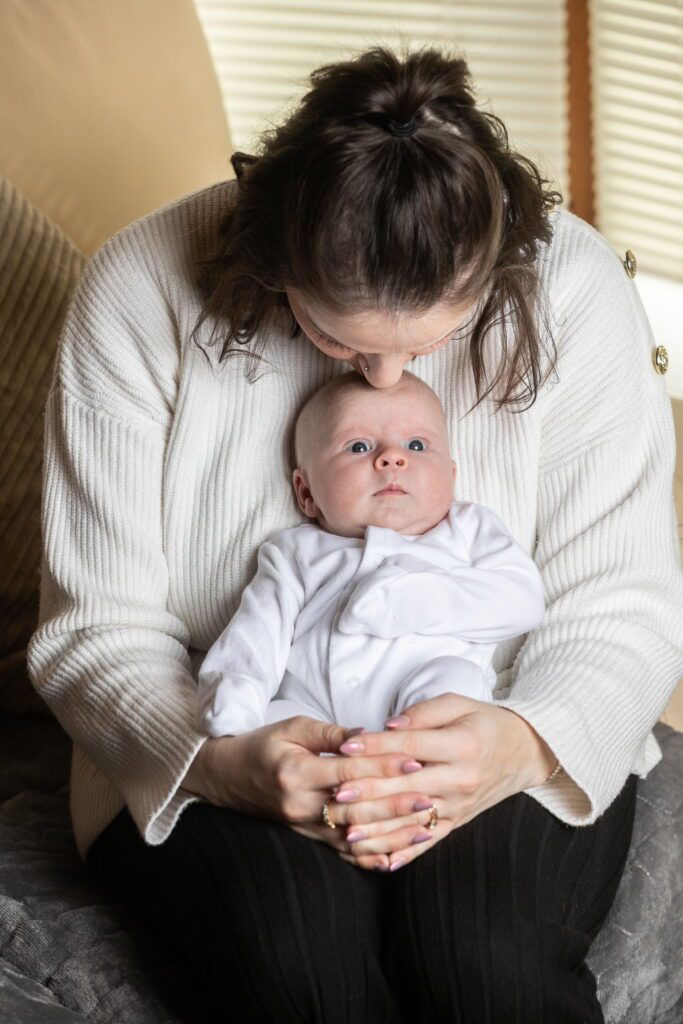
Rebecca said: “I am very lucky and very grateful to have her, she is just so precious.
“Rubylee is brilliant, just perfect and she eats so much – she’s like her dad.”
The now mother from Wilberfoss, in Yorkshire, had two years of chemotherapy and radiotherapy before doctors declared the Ewing Sarcoma tumour which had affected her rib cage and lungs as not active in July 2023.
This means that every three months she has a check up and a CT scan to check if the cancer has reactivated.
In late July 2024 Rebecca began “feeling sick” fearing her cancer had returned.
Rebecca said: “I had a CT scan coming up and they ask you if you are pregnant.”
“I was feeling sick at the time and I was worried that the cancer may had come back.”
“I did a pregnancy test on the off chance and it came up positive but I thought it must be a mistake because of everything my body has been through.”
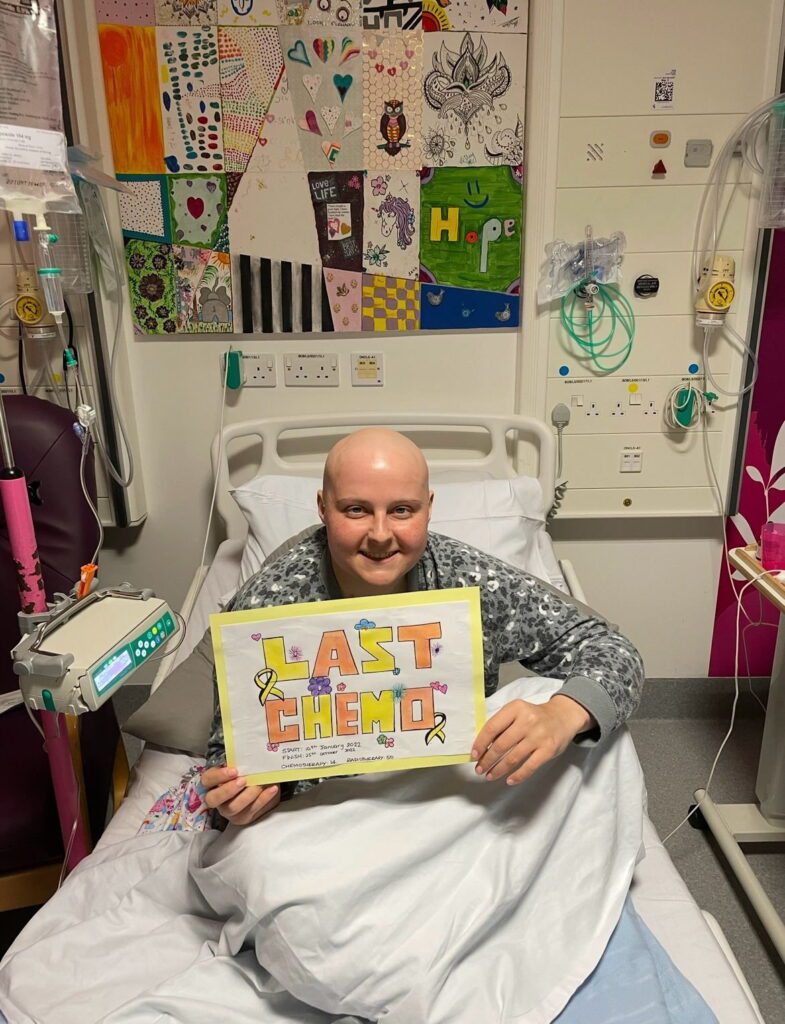
A couple of days before the CT scan, on August 2, Rebecca had an ultrasound to doublecheck if she had a baby on the way.
Rebecca said: “It turned out I was 11 weeks and four days into my pregnancy.
“The lady doing the scan had tears in her eyes and I had to go off and cry as it was such a shock.”
“I told Kris, but then we were worries whether or not we’d be able to keep the baby, but we got in touch with the team in Leeds and they were great.”
Around seven months later Rebecca gave birth to her daughter who weighed 7lb on Thursday February 20.
She was named Ruby after Kris’s grandma and Lee after 22-year-old TikTok star Leah Smith, from Woolton, Merseyside, who had Ewing’s Sarcoma like Rebecca and died last year and May after her grandma.
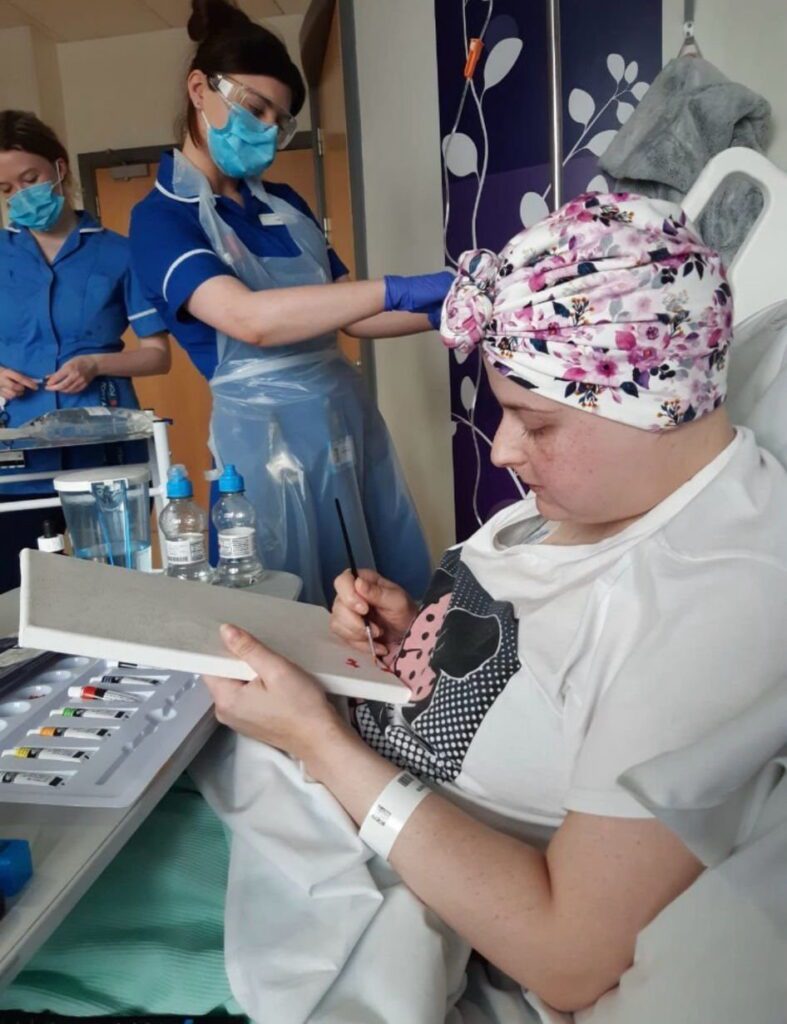
Rebecca, from Wilberfoss, Yorshire, became friends with Leah as they share the type of same cancer.
She said: I never got to meet her, but she helped me after I was diagnosed.”
Before she became ill with cancer for the second time Rebecca worked as a beautician.
She now studies media make-up, special effects, and hair design degree at York College.
She finished the first semester but has since been deferred until January 2026.
For now Rebecca said she’s enjoying being mum to Rubylee, who is now four weeks old, and her dog Smokey a cockapoo.
She said, “I’ve pretty much got my hands full.
“It just goes to show you shouldn’t give up hope as you never know what’s round the corner.”


